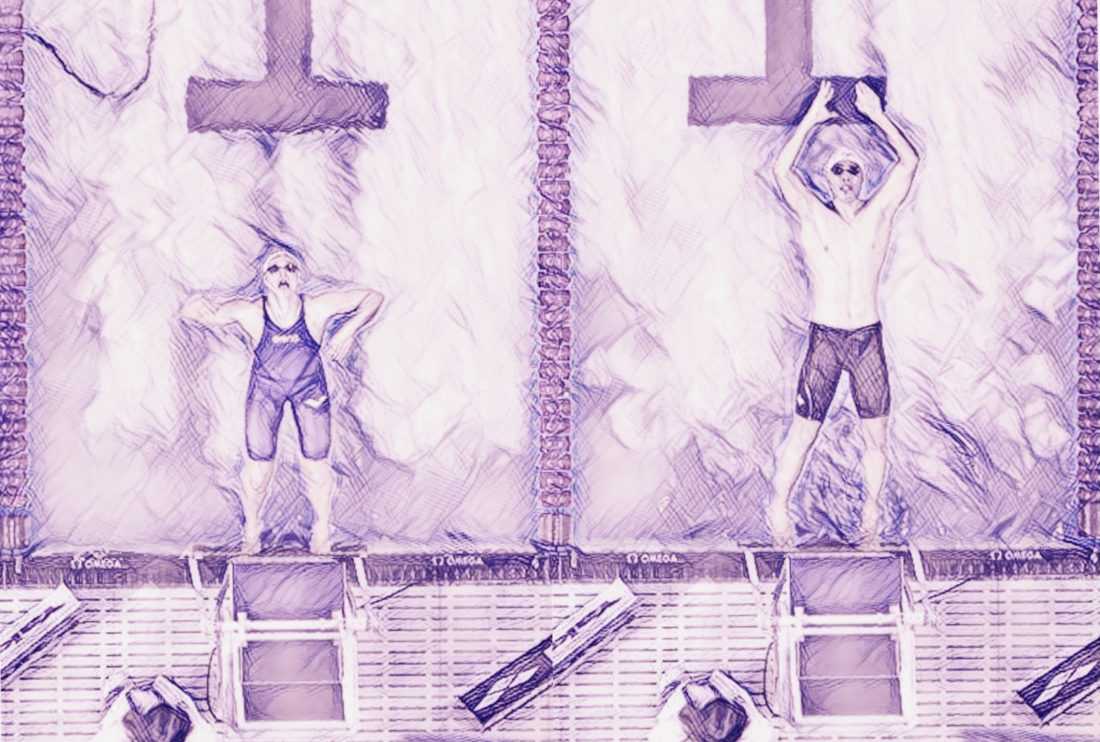Nancy Hogshead-Makar On Trans Inclusion, Part 1: ‘Fight Or Resign Yourself To Sexism & How That Plays Out In Women’s Sport’

In Atlanta today, trans athlete Lia Thomas will race for the University of Pennsylvania in the 500 yards freestyle as the fastest entry at the U.S. college showcase NCAA Swimming & Diving Championships.
In this first of a two-part feature looking at the issues Lia’s presence raises, we talk to Nancy Hogshead-Makar, the triple Olympic gold medal winner who founded Champion Women and became a legal eagle in the rights and advocacy of Safe Sport and ensuring a healthy environment for women in sport, influencing athlete rights legislation along the way.
The presence of a trans athlete who raced as a good but average-standard man for Penn as a man two seasons ago, has sparked rule changes and controversy and generated headlines around the world, not least of all because Lia is no longer ranked outside the best 450 men in U.S rankings as was the case when she was Will in 2019, but is the force to beat in a country that boasts world No 1 swim-team status.
The Thomas controversy has also led to social-media interest spilling from fans to wider world, communities that are both commenting in this fashion after Thomas swamped Olympian Brooke Forde in 500y heats in Atlanta to claim lane 4 for the final this evening:
The trans saga has sparked petitions signed by a Who’s Who of swimming names in support of preserving women’s swimming for biological women, debates over the meaning and manipulation of the term inclusion and why independent checks and balances on governance in sport are essential.
In the background is a trail of science, twists and turns in inclusion policy, and campaigning efforts of those like sports scientist Ross Tucker, who delivers cold turkey when it comes to a dependence on testosterone as the touchstone of the trans inclusion debate in a sport that saw a 200 yard freestyle become the yardstick by which we might measure the concentration of poison being poured in the women’s pool this winter.
Part 1: Where Inclusion Means Discrimination
I start by asking Nancy to sum up where women’s rights in sport have got to down the decades since she was a world-class athlete, rape survivor, three-time Olympic gold medallist and then on through many years of legal training, qualification and the advocacy for Safe Sport in a sport and in a country that dragged its heels on abuse and failed to protect generations of women swimmers from rogues, some of whom continue to be lauded and held in high esteem, including recognition in the International Swimming Hall of Fame (ISHOF).
In words that might be interpreted as resignation but actually amount to an invitation to women in sport to wake up to the “entrenched and nefarious … sexism” in their work place. She tells me:

“So, I will be 60 in April. So one month and the older I get the more I see that this is not going to be solved in my lifetime. And that is I in my younger career, if I could get it across to younger women, is for them to appreciate just how entrenched and nefarious that sexism is, particularly in sport. And that moving the needle is a question of ‘if you are not willing to be in it, you know, dog in, dog out’, right, if you’re not willing to be dog in [the fight], then you’re just going to have to resign yourself to sexism in sport and how that plays out.”
Nancy Hogshead-Makar – Champion Women
The acceptance factor is fairly prevalent on many serious issues of abuse, various kinds, in swimming, and plays out in many ways, as seen in the pandemic when many sports showed they had a louder voice and stronger lobbying stance than swimming despite the fact that pools with good protocols in place were among the safest places to be. Beyond the very elite level, swimming was largely shutdown for lengthy periods of lockdown in many parts of the world and the sport has emerged from that phase of the pandemic with a weak economy, clubs struggling and many pool facilities permanently closed or at the centre of community struggles to keep them open.
In the transgender debate, the trans lobby has included a community that has been vocal and vicious in its insistence on having its demands for full inclusion in women’s sport regardless of any issues of fairness for biological women. Lia Thomas, the Penn athlete at the heart of U.S. college controversy this season, is on message with that lobby, telling Sports Illustrated, “I’m a woman, just like anybody else on the team”. If only that were true. In sport, in swimming, it most definitely is not true: Lia Thomas has male physical advantages that no testosterone reduction therapy could ever take away, including size of limbs, lungs, feet and hands, angle of buoyancy and much else.
And yet, Penn women’s team was told not to air reasonable objections that amounted to ‘we fully support Lia and her transition … but we do not think it fair for her to swim on the women’s team because we have no chance!’. College bosses, with their Ivy League brains, would have none of it: women, that half of all sports people in the world, had no right to rights as biological women and must even give up their right to free speech (a crime under the First Amendment?) but one trans athlete must be given all the rights in the world and a voice in the bargain.
I ask Nancy what she thought of a rule that would place all trans athletes in the men’s competition and call it open. How would that go down. “I can tell you how it go down,” she replies. “For men, it would be no big deal because trans women and trans men are not competitive against the best male athletes, so, you know, it doesn’t throw a Monkey Wrench into the whole thing.”
Perhaps men would object, though, on the grounds that they would be “open” not “men” anymore? “Right,” says Nancy before noting with hand signals that indicate two worlds that operate under different rules for good reasons:

“There’s an ideology which is not based in fact, that ideology says that trans women are women and for most of society, nobody’s going to have a problem with that; until you bump up against the biology of facts and science over here that says ‘hold on, when it comes to competitive sports, trans women are not women. The way I lingo it is … trans women cannot qualify for the women’s category, in just the same way that if somebody uses performance enhancing drugs twice, they are banned for life. So a trans woman who’s gone through male puberty should be banned for life from the women’s category because they have unfair advantages, the same advantages that we know biological women have when they take testosterone.”
Nancy Hogshead-Makar – image: courtesy of SwimSketch – unfair advantage, through doping or transition, should be banned, says Hogshead-Makar
In terms of trans women who grew from boy to man before transitioning, testosterone is just one part of the equation on the side of what can be reversed by what could be described as “anti-doping doping” therapies such as testosterone reduction. Feet size, limb length, angles of bouncy, chest and lung size and capacity are among things that cannot be changed, cannot be reversed.
Nancy points out how women are already having to work hard to change the lexicon of college sports. “Women are working hard right now, on social media accounts and elsewhere: right now [in much of U.S. college sport], there’s sport and then there’s women’s sport, so they don’t want it to be just ‘open’. So, it’s been like this, Duke basketball, and then the women’s Duke basketball. Women want it to be men’s basketball and women’s basketball, so even that is a problem to suggest it would be open category.”
Or at least in the absence of absolute clarity. I mention some suggestions being made at global level that would have ‘women’, defined by biological sex, ‘men’ and an open category in which transgender athletes could race in heats and may be eligible to make the men’s final, on grounds that all transgender athletes have male advantage over women, whether that is because they are from boy to man before transition or whether they have had testosterone boosting treatment under a TUE (therapeutic use exemption) as part of transition. An open winner award could be granted from best of heats or best in final.
“Excellent,” says Hogshead-Makar, her reaction to the notion that there must be inclusion but not in any shape or form that leaves biological women at a disadvantage. That’s the challenge facing FINA as it settles on a workable model that satisfies both Fair Play for women and inclusion for transgender athletes.
It took a crisis for USA Swimming to sharpen its inclusion policy, while the International Olympic Committee (IOC) changed the game late last year when it handed down responsibility to international federations such as FINA when it asked them to revisit the subject from the specific perspective and nature of the sports they govern. On one level, the IOC’s new stance was regarded as an abdication of duty in terms of it’s power to hand down a common rule for all but the decision also meant that swimming would not be treated like darts, equestrianism would not be treated like hammer and long jump, and so on and so forth.
Frustration remains in the week Lia Thomas races at NCAAs against a backdrop of decades of discrimination and harm done to women in swimming.
It is not as if we could not see all of this coming.
Cassandras & the Shifting Tide & Meaning Of Trans Inclusion
I invite Nancy to join me on a short trip back through the past decade, to a 2013 ‘Cassandra-alert’ article I wrote on SwimVortex, to the numerous times Nancy has raised the transgender challenge in the past 3-4 years alone, to my 2019 article “A Waking Nightmare for Women’s Sport”, all part of many signposts and signals and reminders that women’s sport, yet again, was the realm being asked to suck it up, to stomach unfair play. That we get to 2021-2022 U.S. college season with no adequate rules in place, guaranteeing that Lia Thomas would be exposed, as she most certainly has been, in headlines around the world, must surely be described as governance failure, right? Says Nancy:
“Yeah, I agree with you. It’s a governance failure. So, when I think of how the arguments in favour of pure trans inclusion have changed throughout time, I recall we were told initially by Pat Griffin [LGBTQ sports inclusion advocate] and Helen Carrol [Sports Project Director at National Center for Lesbian Rights] in the NCAA meetings. I was in the room. We were told that a transgender woman’s ranking … would be about the same as it had been when they competed as a male after one year of gender-affirming hormones and that their times would roll back male puberty after a year on gender-affirming hormones. “
So, circle squared, fairness would be served and there would be no male advantage retained? Says Nancy:

“Look, I’m a lawyer. I depend on what the scientists say, and what they were saying was just that. Okay, so that was step one. A little bit later, it turns out we get more signs and say ‘hold on, that’s not true; that is bad science and now we have better science’. Then the response was two things: one is ‘well, transwomen are women, so women should be open and they should be welcoming’; then two was the idea that ‘it’s just never going to happen Nancy; you’re not going to have any trans women who are going to be winning any kind of meaningful category’
“They started with high School and saying ‘look, it’s just two high school girls, what difference does it make?’ In time, we’ve seen more and more [which direction its actually heading in]. With Lia, we see not just the potential for winning NCAAs but breaking Missy Franklin and Katie Ledecky’s records. That’s a whole new animal. I think most people look at it as I do: that’s a taking not a sharing.
Nancy Hogshead-Makar – image: The advantages over women in sport of a transgender athlete who benefitted from male puberty can be seen off every wall and the splits down the lane line – image, cartoonized photo by Patrick B. Kraemer
She adds: “So now we know much more where the science is but we also know that … sports governing bodies are afraid of speaking out on behalf of biological women. They have been cowed; there is a philosophy that anything other than just pure inclusion, not even taking gender-affirming hormones, but anything other than pure inclusion is transphobia; it is trans hate; it is ‘you are doing violence to trans people’; that ‘you are enabling these state law bills that won’t allow transgender athletes to participate at all’.
“You know, I don’t agree with those bills at all. I think that we need to figure out how to include transgender athletes into the sport construct. But not at the expense of women, not at the expense of girl. It’s just not rocket science. That can be done. Right? But you have to be, you have to like, you know, sit down in a room with goodwill and with other people and look at the science; have people agree on what the science is. Right now, the trans advocates are saying ‘there is no science’ – and that is a lie. There is phenomenal science.
“And so we know what what puberty does, we’ve known the difference between men and women in strength and VO2 max [the amount – volume – of oxygen your body uses while exercising as hard as you can] for a long, long time. We know what puberty blockers do and we know what testosterone reduction does etc. Basically, when it comes to something other than a marathon event, the science says that you can’t roll back male puberty; if what you’re relying on overwhelmingly is VO2 max, as opposed to a two-hour marathon event, then a trans woman is just not going to be able to compete in the girl’s and women’s category.”
The Suicide Plea
As the voice of science grew louder in the debate, the arguments of the trans lobby shifted. Says Nancy:
“What I’ve noticed is that the the arguments in favour of trans women inclusion has changed over time. Reasonable people would say, yes, we know there’s science and there are many more people feeling uncomfortable with trans athletes competing in the women’s category but the rationale turns to ‘trans people face so much hate and harm out there in society that you know, they may commit suicide’.
Harvard athletes were told that that they had a transgender athlete, who was a transgender male, a biological female going into the men’s category. Schuyler Bailar is now a full-time advocate for transgender athlete inclusion. Virtually nobody has any issue whatsoever with Schuyler, with a transgender man, competing in the men’s category. It’s sort of a weird that they would be a full-time advocate just from that perspective because there’s no pushback, right?. It’s all ‘go, go, go’ because you don’t have an unfair advantage here, right?
So what they would say is that their lives are so bad, transgender women in particular, that, you know, you should just let them be able to participate and I disagree with that.”
Nancy Hogshead-Makar – image: The advantages over women in sport of a transgender athlete who benefitted from male puberty can be seen off every wall and the splits down the lane line – image, cartoonized photo by Patrick B. Kraemer
Nancy’s point is made for her in a variety of Schuyler’s advocacy presentations and interviews that you can find online. Take the following video and interview with Schuyler as a prime example: heartwarming story all round but it is also clear that some of the key the issues he raises, very real as they are, are specific to a biological girl who transitioned to a man. While some issues have clear parallels for all trans athletes, some very significant aspects of Schuyler’s story clearly do not apply to biological males on a journey as a trans women, particularly when it comes to sport. Indeed, the differences are not only immense but at the opposite end of a spectrum of advantage/disadvantage. See if you can spot them:
Says Nancy: “I understand that trans people face a lot of discrimination out there in society, but surely we can deal with that separately from having women take the butt of all that. Why impose all these burdens just on women? Could it be sexism? I really have a hard time with all these people who just think ‘it doesn’t matter, women’s sports don’t matter; it’s just not a big deal’. It’s like ‘come on, just be gracious will ya!'”
The Lived Experience Of Women
The suicide argument for inclusion is not only warped by a conclusion of ‘come on, women, suck it up because otherwise you have the deaths of these people on your hands’ but by the obvious wilful blindness to what women in sport have endured for decades.
I mention Nancy’s own experience as an example among many of women who survived rape, sexual assault and other forms of brutality and injustice down the decades often with no support, no backing, not even a word of comfort from their sports communities led, in comprehensive numbers, by men; I mention the harm, the trauma, the mental health problems, the sense of being robbed and the realisation that the police are there to offer more protection to the rogue than the victim.
That terrible truth has played out in women’s sport in a variety of ways, including the treatment of those in sport who suffered sexual abuse but were told to go home and stay quiet to avoid embarrassment and those like “surly” Shirley Babashoff, Wendy Boglioli, Nancy Garapick, Cheryl Gibson, Sharron Davies, Michelle Ford, Conny van Bentum, Enith Brigitha and many more who must still listen to the IOC’s voice of Gríma Wormtongue telling them ‘sorry, statute of limitations, nothing we can do’ even though it was their own IOC-accredited laboratory that concealed systematic cheating on a grand scale in the days of the GDR rather than serve the purpose it was licensed for: catching, not protecting, cheats.
Just as the generation of Boglio and Babashoff, Davies to Van Bentum and Co had to dig deep and find a way to compete against injustice, so too have the women at NCAAs in Atlanta this week had to find a way of fighting on while knowing that governors had placed them in a lane next to unfair competition.

I note that the ‘many more’, as Sharron Davies, Michelle Ford and others have pointed out, include people you never heard of, people who would have been an Olympic medallist, even and Olympic gold medallist but got lifetime anonymity for their efforts instead. I note that the harm has lasted an entire lifetime, that parents, including those like Sharron Davies’ father and coach, now in his 80s and still coaching, have lived with a sense of loss, too. Some have died, some have turned to counselling to help them deal with having to watch their daughters abused and robbed.
Says Nancy: “Right. Sharron Davies. It would have been gold. You are spot on. And when you think about just the sexual violence rates that women have, it’s one in three girls under the age of 18 and you and I have talked before about my experience.

“For me, sport was my healer, sport was where I healed from sexual violence. It calms. We know now what we didn’t know back then, we know now that hard, hard physical exercise is a way of calming the brain down. So I could make the argument that, you know, if you want to play ‘who’s more discriminated against’, then it’s women.”
Nancy Hogshead-Makar – image, Nancy in her racing days
No-one wants to play down a single suicide but neither should anyone play any of it up to suit an argument for inclusion in sport of the kind that delivers its own discrimination. Nancy points to a Google search for evidence of trans women and men who were killed or committed suicide in the past year in the United States. The number was 42. That’s 42 too many. That’s also part of this perspective, Nancy notes: “That’s [the number] for Jacksonville, Florida, my hometown, for women when it comes to people being killed by their significant other and suicide. I’m not unsympathetic at all. But it’s just that it’s not a good reason to destroy girls and women in sport.”
Part 2 coming soon…